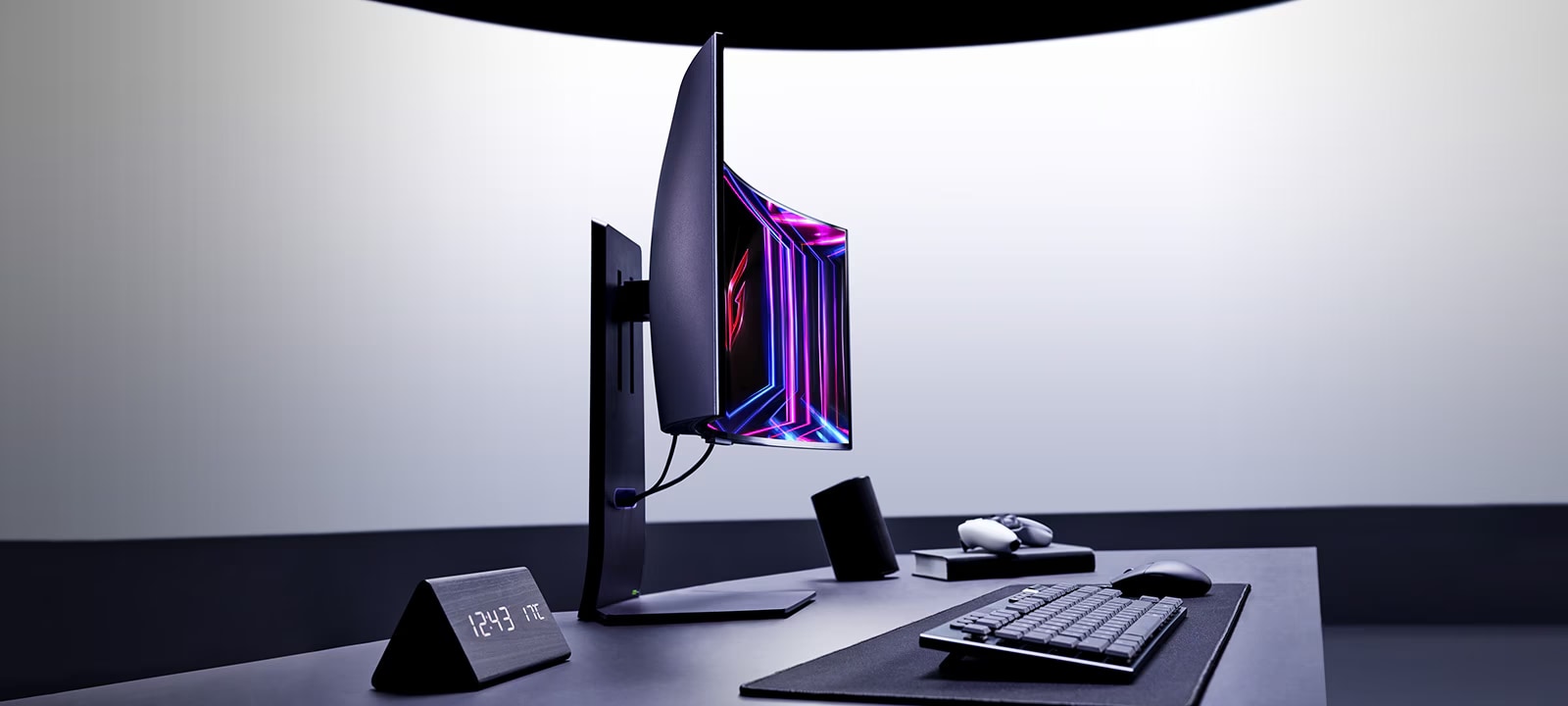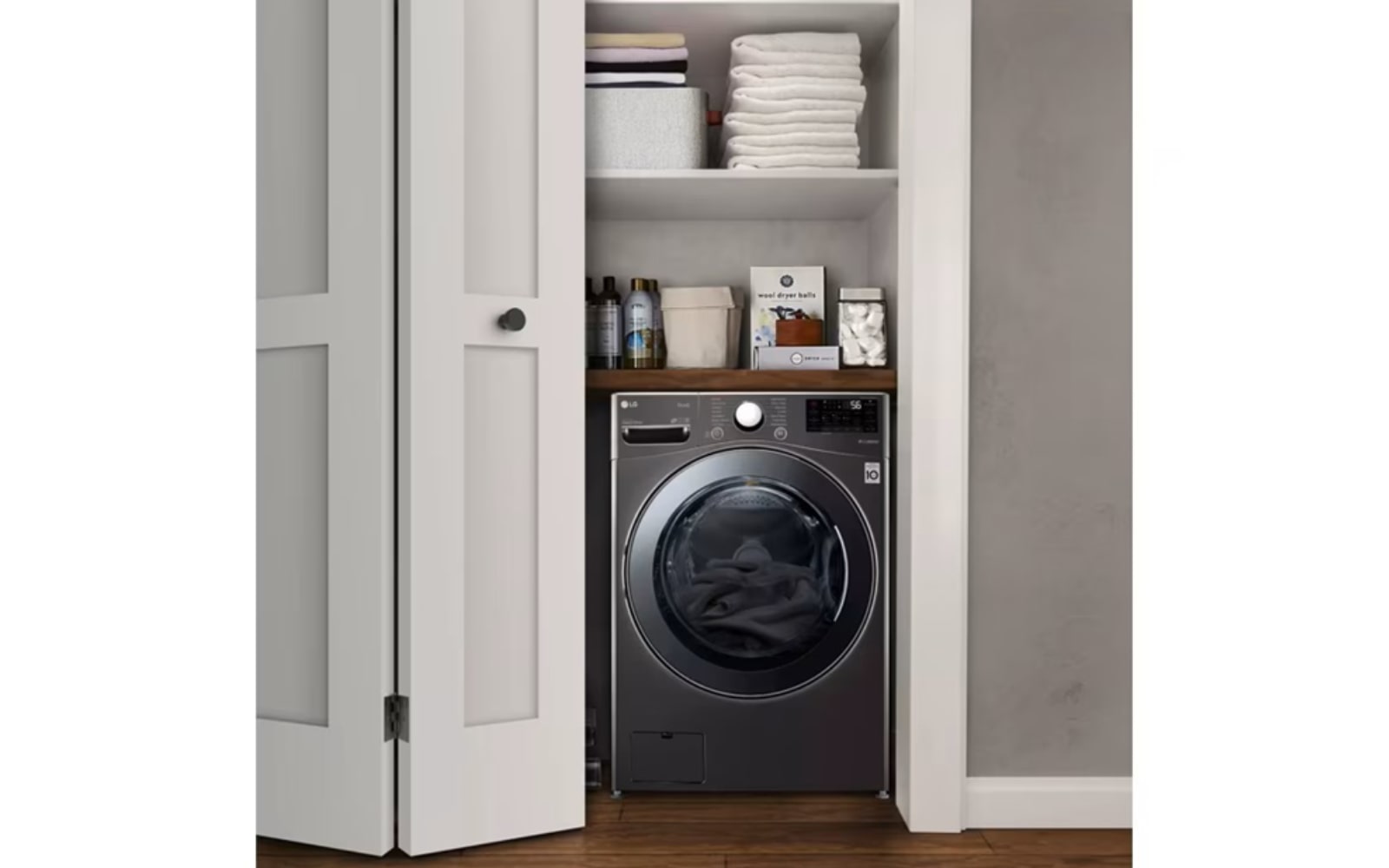We use cookies, including cookies from third parties, to enhance your user experience and the effectiveness of our marketing activities. These cookies are performance, analytics and advertising cookies, please see our Privacy and Cookie policy for further information. If you agree to all of our cookies select “Accept all” or select “Cookie Settings” to see which cookies we use and choose which ones you would like to accept.
Want to dive into the ultimate focus zone? Curved monitors might be just what you need for a fully immersive experience.
This article will cover:
- The benefits and drawbacks of curved monitors.
- Key factors to consider when choosing a curved monitor for gaming or work.
- Various monitor curvature ratings and what they mean.
Curved monitors are designed to enhance your viewing experience by wrapping the display around your field of vision. They create a sense of depth and dimension on the screen, which helps reduce eye strain, minimise reflections, and cut down on image distortion. Plus, they offer a broader field of view compared to flat screens, providing a richer, more engaging experience. The sleek, modern design of a curved monitor can also add a touch of style to your workspace, acting almost like a piece of art when not in use. For gamers, a curved monitor can make gameplay feel more immersive and engaging.
While curved monitors offer heaps of benefits, they might take a bit of time to get used to. Viewing from an angle other than directly in front can be tricky, so they might not be the best choice if you’re planning to watch movies from your bed or sofa. Also, curved monitors can need a bit more desk space because of their design, but the difference is usually minimal.
Are Curved Monitors Good for Work and Gaming?
Curved monitors let you dive right into your viewing experience. But that’s not all they have going for them. Keep reading to discover why a curved monitor might be your top pick, especially if you're into gaming!
Interactive Visual Experience
The curve of the display screen wraps around your field of vision, creating a more natural and interactive visual experience. This means you’ll feel like your game is happening all around you, rather than just in front of you.
Improved depth perception & Immersive gaming experience
Are curved monitors good for gaming? The answer is yes. Curved monitors enhance the sense of depth and dimension on the screen. The curvature makes the content appear more three-dimensional, giving you a clearer sense of distance and positioning. This is particularly beneficial for gaming, as it enhances your overall gameplay experience.
In gaming, having a clear field of view and accurate depth perception is crucial for an engaging experience. A curved monitor provides this immersive feel by naturally wrapping the visuals around you. The curve helps achieve better depth and dimension, making the length, width, and height of the game environment appear more three-dimensional. With the screen’s curvature, you’re positioned directly in front of it, allowing you to be fully immersed in the action—ideal for fast-paced and action-packed gaming sessions.
Increased visibility and brightness
The curvature of the screen helps cut down on reflections and glaring streaks from the surrounding light. It directs light more effectively towards you, making visibility easier and lessening the impact of any external light, like sunlight coming through windows. This is particularly handy if your monitor is positioned in a challenging spot with lots of natural light or different lighting setups.
Curved screens offer minimal light distortion and help reduce image distortion, giving you a clearer and more consistent visual experience.
Wide field of view
A wide field of view can be a game-changer for various tasks, whether you're gaming, multitasking, or editing videos. Because the curved monitor wraps around more of your peripheral vision, you shouldn’t need to twist your neck as much. This helps keep you comfortable and able take in more information at once—so you won’t miss a thing in your game!
Improved focus
With the screen wrapping around you, it can be easier to stay focused. The curve guides your eyes towards the centre of the screen, which can reduce rapid eye movement and help you find what you're looking for with less effort.
Aesthetics
Curved monitors also add a touch of sophistication and style to any setup. Their seamless design blends beautifully with any space, enhancing its overall aesthetic.
Challenges associated with curved monitors
Price
Curved monitors tend to come with a higher price tag compared to flat screens. However, the investment is often worth it for the enhanced viewing experience they provide. In fact, with a large UltraWide curved monitor, you might find you no longer need dual monitors, as one expansive display can do the job more effectively.
New viewing experience
It’s worth noting that adjusting to a curved monitor can take a bit of time. Initially, it might feel a bit odd as your eyes get used to the new setup. This adjustment period can vary from person to person, as everyone’s eyes will adapt differently.
Content compatibility
Not all content is ideal for curved screens. Some applications, videos, or websites might not fully take advantage of the screen’s curvature, potentially leading to slightly distorted visuals or an inconsistent viewing experience.
One potential drawback is that if multiple people want to view the screen, it can be tricky. The ideal viewing distance is directly in front of the monitor. For those who enjoy high-paced action games, a curved screen might not be ideal, as it could cause motion sickness or discomfort for some users. It might be a bit too immersive if you're highly sensitive.
Available Desk Space
Curved monitors, due to their larger screens and curved design, might require a bit more desk space. However, unless the curve is very pronounced, the difference is usually minimal. If you’re working with a smaller desk and can't expand your workspace, it’s worth checking the monitor’s dimensions to ensure it fits comfortably.
Additionally, the curved design could mean compatibility issues with certain mounting systems or dual monitor setups. It limits flexibility for customisations that you may want to make as well as it not flushing properly with the wall. Ultimately, it comes down to personal preference and what looks best in your space.
How to choose a curved monitor
Space
When picking a curved monitor, it’s crucial to consider how much space you have and how the monitor will fit into your setup. You might find that you don’t like the curve as much personally, so it’s a good idea to visit a store to check it out and see how it feels to use.
Sitting too close to the screen can cause eye fatigue, so aim to position yourself about a metre away from the display for the best experience.
Consider ports and speaker units
Display and ports speaker inputs will be either be on the side of the monitor screen, underneath or behind. Make sure to inspect all possible location to find where the ports are.
Resolution
When choosing a resolution for your curved monitor, there is a range of options to consider, including the 34" 21:9 Curved UltraWide™ QHD (3440 x 1440) Monitor. It’s about finding the right balance between what your games or applications can handle and your desire for high-quality detail. Keep in mind that higher resolutions offer stunning visuals but may require more powerful graphics cards, especially if you’re aiming for an enhanced gaming experience.
Monitor Curvature Rating
What is the best R for curved monitor?
For immersive visuals, go for a smaller curvature like 1500R. For productivity and efficient working, a higher R value might be more suitable.
It’s important to consider all aspects before buying a curved monitor. Available desk space, screen size, resolution, the “R-value,” your budget, and personal preference all play a part in ensuring you invest in the monitor that’s right for you. Think about why you need the curved monitor – is it for gaming, entertainment, or productivity?
If you’re buying a curved monitor for graphic design work, choosing a slight curve will be suitable as it won’t distort the image near the edges of the screen.
Is 1500 R or 1800R more curved?
1500R is more curved than a 1800R curved monitor. The smaller the “R” value is the more pronounced the curvature of the screen will be. Conversely, the higher the “R” value, the less pronounced the curve will appear.
Curved Monitor FAQs
Do curved monitors help in productivity and multitasking?
Yes, curved monitors can help with productivity by enhancing multitasking due to a wider field of view, allowing more applications to be visible on the screen at once.
Can curved monitors cause motion sickness or discomfort?
It’s rare, but some individuals might experience sickness from the nature of the screen curve, especially during high speed content.
Are there any downsides to using a curved monitor?
Yes, curved monitors can have drawbacks, such as being higher in price, requiring an adjustment period to get used to the new setup, and having limited compatibility with certain wall mounting systems.
Can a curved monitor be wall mounted?
Yes, you can find suitable wall mounting systems. Just make sure to check the appropriate height and weight before mounting.
How do I choose the right curvature for a curved monitor?
The choice depends on personal preference and what you intend to use the monitor for. A larger curvature (1800R) is perfect for immersion, while a smaller curvature (3800R) is great for productivity.
Life’s Good!

.png)
.png)
.png)

.png)